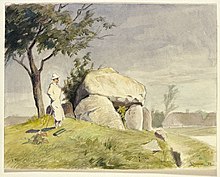Passage grave of Ludserød
The passage grave of Ludserød (also called Ludserød Jættestue) is located in Blovstrød (also Bloustrød), west of Birkerød on the Danish island of Zealand .
The passage grave ( Danish Jættestue ) was built between 3500 and 2800 BC. BC as a megalithic system of the funnel beaker culture (TBK). It is a form of Neolithic megalithic systems, which consists of a chamber and a structurally separated, lateral passage. This form is primarily to be found in Denmark, Germany, the Netherlands and Scandinavia, as well as occasionally in France.
description
The rectangular passage grave, open at the top, is only covered by a capstone at the edge. All bearing stones of the chamber and corridor are preserved in situ . The approximately 4.2 m long and 1.2 m wide chamber consists of nine bearing stones and partially preserved intermediate masonry . The long corridor consists of six supporting stones on each side. The passage grave lies in a well-preserved, oval round hill about two meters high and about 16.0 × 13.0 m in diameter. All the curbs on the hill have gone out except for three on the north side.
See also
literature
- Peter V. Glob : prehistoric monuments of Denmark. Wachholtz, Neumünster 1968.
Web links
Coordinates: 55 ° 50 ′ 31.7 ″ N , 12 ° 23 ′ 28.4 ″ E
